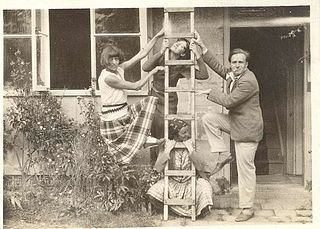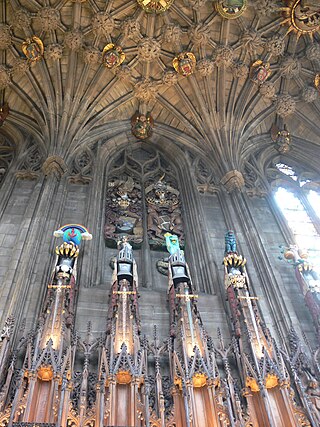Eric Schilsky, RA was a sculptor.

Conrad Dressler was an English sculptor and potter.

Newbury Abbot Trent was an English sculptor and medallist. Trent studied at the Royal College of Art and Royal Academy Schools, where he became an associate. His works include reliefs, statues and other forms of sculpture. Many of his most notable works are war memorials in England, Scotland and Wales.

Thomas Nicholls was an English sculptor.
Thomas Stirling Lee was an English sculptor, specialising in reliefs and portrait heads.
Rose Gwynneth Cobden Holt (1909–1995), was a British artist known for her ivory sculptures on religious subjects. Her most famous work is a depiction of the Annunciation, created circa 1946.

Grizel Rosemary Graham Niven was a British sculptor. She created the figurine presented to the winner of the annual Women's Prize for Fiction, formerly the Orange Prize for Fiction, since its inception in 1996. Known as "The Bessie", the trophy is cast each year with a different mixture of bronze, making each award unique.

Henry Charles Innes Fripp (1867-1963) was an English painter, genre artist and illustrator, stained glass maker, designer, and teacher. Many of his illustrations appear under the name Innes Fripp.

Stephen Tomlin was a British artist associated with the Bloomsbury Set. He was the youngest son of the judge and law lord Thomas, Lord Tomlin of Ash.

Fred Kormis was a German sculptor. Kormis gained recognition for his bronze portrait medallions. Amongst a total of 41 pieces exhibited at Royal Academy the subjects included Edward VIII, Winston Churchill and Charlie Chaplin. Examples of his medallions are to be found in the National Portrait Gallery, the British Museum and the Royal Collection.

Percy Hague Jowett (1882–1955) was a British artist and arts administrator, principal of the Royal College of Art from 1934 to 1948.
Reginald Fairfax Wells was an English sculptor, potter, aviator, aircraft designer, aircraft manufacturer, and architect.
Ella and Nelia Casella were British artists, sculptors, and medalists, known for their collaborative work. Both sisters worked frequently in wax, creating portraits which are now held by the Victoria and Albert Museum. They worked together on a variety of illustrations and medal commissions.
Gladys Caroline Barron née Logan (1884–1967) was an English sculptor and painter renowned for her portraiture.
Alice Lindley-Millican (1885–1930) was a British sculptor known for her figurative works.
Ann Compton is an art historian and an Affiliate in the History of Art, School of Culture & Creative Arts at the University of Glasgow. She has worked on a major project, 'Mapping the Practice and Profession of Sculpture in Britain and Ireland, 1851-1951', as Originator, Director and Editor. She is a Research Consultant on this project and is a member of the Sculpture Steering Panel at Art UK. She is a widely published author of and contributor to publications in her field. She is a member of the Advisory Board of the journal 'Public Monuments and Sculpture Association' (PMSA).

Charles Bacon (1821–1886) was an English sculptor primarily remembered for his equestrian statue of Prince Albert at Holborn Circus in central London.

Joseph Hayes (1869–1916) was a Scottish sculptor and art teacher. He is best known for the Thistle Chapel within St Giles Cathedral. His career was cut short when he was killed in the First World War.
Stanley Nicholson Babb, FRBS (1874–1957), also known as S. Nicholson Babb and Nicholson Babb, was a British sculptor.

Benjamin Cheverton was an English sculptor and inventor. With the assistance of John Isaac Hawkins, he designed and operated a novel pantograph machine to create detailed miniature reproductions of sculptures, primarily busts of historical and mythological figures by contemporary sculptors like Francis Leggatt Chantrey, Louis-François Roubiliac, and Joseph Durham. His reproducing machine, which was exhibited at the Great Exhibition of 1851, is now in the collection of the Science Museum, London. A large collection of his work is found in the Thomson Collection at the Art Gallery of Ontario.











